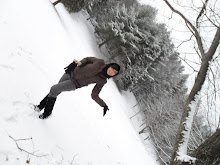Manet’s last painting ‘Bar at the Folies Bergères’, which seems at first sight to be a reflective study of an observer of the main action, turns out to be a paean to visual space. The simple composition of the woman behind the bar unravels into a sequence of interpretations that each are in counterpoint to the other.
Jeff Wall is a photographer from Vancouver, BC. His unique art is exhibited and represented worldwide. In “Picture for Women” (1979) he interprets Manet’s masterpiece by changing the setting to a photographer’s studio. In Manet’s painting, the central figure, a barmaid with downcast eyes, receives a gaze from the male customer reflected in the upper right corner of the mirror behind her. The customer is located in an impossible perspective that simulates the one occupied by the viewer of the painting. The key features are the male gaze by itself, the relationship towards the female and the viewer as an active, involved onlooker.
When Wall composed his photograph, he set his camera, seen as a mirror reflection, at the center; the woman stands at the left, coolly studying the camera and the photographer beside it. The camera and its operator become the central subject of the picture and the object of feminine scrutiny. Wall mimicked the receding globe lights of the Folies-Bergère bar into the overhead bulbs, deepening the space in the photo as Manet did in his painting

There are some common elements in the two images. But they are so vastly different it is hard to see a real relationship between the two. The warm intimacy of Manet contrasts too much with Wall’s cold, stark image. Manet shows a servant engaged by a probing Parisian male while the Wall image allure to an antagonistic relationship between the two characters without any joy whatsoever
Jeff Wall is a photographer from Vancouver, BC. His unique art is exhibited and represented worldwide. In “Picture for Women” (1979) he interprets Manet’s masterpiece by changing the setting to a photographer’s studio. In Manet’s painting, the central figure, a barmaid with downcast eyes, receives a gaze from the male customer reflected in the upper right corner of the mirror behind her. The customer is located in an impossible perspective that simulates the one occupied by the viewer of the painting. The key features are the male gaze by itself, the relationship towards the female and the viewer as an active, involved onlooker.

When Wall composed his photograph, he set his camera, seen as a mirror reflection, at the center; the woman stands at the left, coolly studying the camera and the photographer beside it. The camera and its operator become the central subject of the picture and the object of feminine scrutiny. Wall mimicked the receding globe lights of the Folies-Bergère bar into the overhead bulbs, deepening the space in the photo as Manet did in his painting

There are some common elements in the two images. But they are so vastly different it is hard to see a real relationship between the two. The warm intimacy of Manet contrasts too much with Wall’s cold, stark image. Manet shows a servant engaged by a probing Parisian male while the Wall image allure to an antagonistic relationship between the two characters without any joy whatsoever
